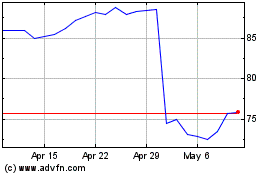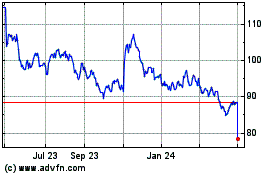Starbucks CEO Turns Focus to Pricier Brew -- WSJ
December 02 2016 - 3:02AM
Dow Jones News
By Julie Jargon
Howard Schultz is stepping down as chief executive of Starbucks
Corp. to lead an effort at the company to build high-end coffee
shops that will charge as much as $12 a cup, his next attempt to
revolutionize the way Americans consume coffee.
Mr. Schultz, 63 years old, is handing over the CEO role to Chief
Operating Officer Kevin Johnson, who served as a director of the
company for seven years before joining its executive team two years
ago. Mr. Schultz, who is credited with taking the company from
small beginnings to an international behemoth, began handing over
daily oversight of the company to Mr. Johnson a few months ago.
Starbucks's move toward high-end coffee, a project referred to
internally as "Siren Works" -- after the mythological creature in
the coffee chain's logo -- is aimed at refreshing its brand, which
has been facing increasing competition from specialty roasters such
as Stumptown and Intelligentsia, as well as from mass coffee
purveyors like Dunkin' Donuts, which has been introducing more
drinks such as cold-brewed coffee.
While Starbucks continues to outperform the broader food retail
industry, its sales growth has slowed in recent quarters.
Mr. Schultz will remain chairman of Starbucks after he steps
down as CEO in April and said he has no plans to step away from the
company. "This gives me the entrepreneurial freedom to do what I
think I do best," he said in an interview.
But the big bet is based solely on Mr. Schultz's instinct that
it is the right thing to do. "There was no research," he said.
Convincing his board and senior management team to create another
brand wasn't easy.
Mr. Schultz changed the way Americans drink coffee and even
socialize, creating what he called a "third place" where people
could gather outside home and work.
Starbucks showed Americans that coffee could be more ambitious
than home-brewed Folgers. Mr. Schultz joined the original company
as its marketing director in 1982 and, after a dispute with its
then-owners, left in 1986 to open his own coffee shop, which he
named Il Giornale. He later bought the Starbucks coffee business
from the original owners, renamed his own shop Starbucks and went
on to expand the brand to more than 25,000 stores across the
globe.
Mr. Schultz said the move to opening high-end coffee shops marks
the company's biggest strategic change since it began opening shops
overseas 20 years ago. Mr. Schultz said the approach would provide
an experience that would entice consumers, who are increasingly
shopping online, to leave their homes.
Analysts see plenty of risks for the new venture. If the economy
falters, they say, investors won't be too keen on Starbucks
spending what some estimate will be roughly $100 million a year
building fancy new stores that may draw few customers.
Mr. Schultz was encouraged in part by the outsize sales
performance of the company's first such shop, the Starbucks Reserve
Roastery and Tasting Room in Seattle. There, coffee is roasted and
then brewed using a variety of methods by top Starbucks baristas
recruited from around the country. A 12-ounce cup of small-batch
coffee brewed using a process involving a siphon costs $12.
The Roastery is the 15,000-square-foot embodiment of an idea Mr.
Schultz dreamed up seven years ago. In his journal, he scribbled
the words "the Willy Wonka of coffee," thinking that someday he
would build a grand temple to coffee. At that time, Starbucks was
still the predominant place to buy a good cup of coffee. But the
better-coffee market has since become crowded.
Nearly two years after the Roastery opened in an abandoned Volvo
dealership in Seattle Starbucks is planning to open 20 to 30 more
like it, including one twice its size in Shanghai next year.
The company plans to build as many as 1,000 smaller stores
similar to the Roastery, minus the on-site roasting, under the
Starbucks Reserve brand, with a logo that consists of a gold star
and the letter "R." The first two stores are slated to open in
Chicago and Seattle in the summer.
Starbucks is also remodeling many of its more than 25,000
Starbucks stores with Reserve-branded coffee bars where customers
can get the same kind of coffee education and variety of brewing
methods as at the Reserve stores.
Mr. Schultz said he built his case for the new operation by
studying other companies that have successfully extended their
brands, such as Porsche's creation of a luxury sport utility
vehicle, which was initially met with skepticism, and Nike's
creation of the Air Jordan brand.
Cliff Burrows, who left his role running the Americas division,
Starbucks's largest business, to join Mr. Schultz on the new
project, said: "I've worked with Howard a long time, and there are
times he has a vision and clarity that those of us around him don't
see but we accept it," he said.
Moving too far upscale could be a distraction to the operation
of Starbucks's traditional coffee shops. Credit Suisse analyst
Jason West said: "The menu is getting complex at Starbucks. If
you're going to throw on top of that another level of
premiumization and innovation and add an espresso bar, this could
make things more challenging."
Write to Julie Jargon at julie.jargon@wsj.com
(END) Dow Jones Newswires
December 02, 2016 02:47 ET (07:47 GMT)
Copyright (c) 2016 Dow Jones & Company, Inc.
Starbucks (NASDAQ:SBUX)
Historical Stock Chart
From Mar 2024 to Apr 2024

Starbucks (NASDAQ:SBUX)
Historical Stock Chart
From Apr 2023 to Apr 2024
